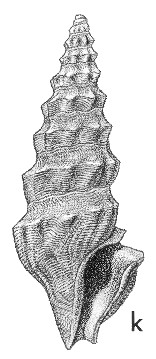
Revised descriptions of New Zealand Cenozoic Mollusca from Beu and Maxwell (1990)

 | Revised descriptions of New Zealand Cenozoic Mollusca from Beu and Maxwell (1990) | 
|
  (Pl. 26k): holotype, Pakaurangi Point, Kaipara Harbour, probably Altonian (TM4946, GNS) |
Beu & Maxwell (1990): Chapter 11; p. 237; pl. 26 k.
Synonymy: Drillia tenuispiralis Marshall 1918, p. 269
Type species of Austroclavus Powell, 1942
Classification: Drilliidae
Description: Rather small for family (height 10-12.5 mm), elongate-ovate, spire 0.6 total height. Protoconch conical, of 4 smooth whorls. Teleoconch of 7 whorls, sharply shouldered near middle on spire, sutural ramp steep, slightly concave; last whorl excavated, with short, rather broad neck. Axial sculpture of prominent, opisthocline, rounded costae with broad interspaces on spire, extending from lower suture to shoulder angle where they are sharply and abruptly truncated forming a serrate periphery; extending across base but not onto neck on last whorl; 9-11 costae on penultimate whorl. Spiral sculpture of a few very feeble threads on ramp, and considerably stronger but nonetheless fine threads below, extending onto neck. Aperture rather narrow, with a short, strongly notched siphonal canal. Inner lip with a heavy parietal callus pad, narrowly but quite thickly callused below; columella slightly convex. Outer lip with deep, constricted anal notch on ramp, directed somewhat away from aperture, a heavy rounded varix below; well preserved shells with a shallow "stromboid notch" near anterior end.
Comparison: A related, undescribed species from Parengarenga Harbour (Altonian) differs from Austroclavus tenuispiralis in having fewer, noticeably coarser spirals on the base and neck. A. marshalli (Pl. 22o) is more slender, does not have the axial costae sharply truncated at the shoulder angle, and has spiral sculpture restricted to the neck. Austroclavus ranges from Waitakian to Clifdenian in New Zealand, although as noted under A. marshalli, it seems unlikely to be separable from Splendrillia, many drilliids having lost planktotrophy independently. It is also recorded from the Middle Miocene of Victoria, Australia. New Zealand representatives occur in mid-shelf to upper bathyal assemblages.
Distribution: Altonian; Pakaurangi Formation, Pakaurangi Point (type); Fouraye Siltstone and Calamity Point Sandstone, Clifden.
Cite this publication as: "A.G. Beu and J.I. Raine (2009). Revised
descriptions of New Zealand Cenozoic Mollusca from Beu and Maxwell (1990). GNS
Science miscellaneous series no. 27."
© GNS Science, 2009
ISBN
978-0-478-19705-1
ISSN 1177-2441
(Included with a PDF facsimile file
copy of New Zealand Geological Survey Paleontological Bulletin 58 in CD version
from: Publications Officer, GNS Science, P.O. Box 30368 Lower Hutt, New
Zealand)